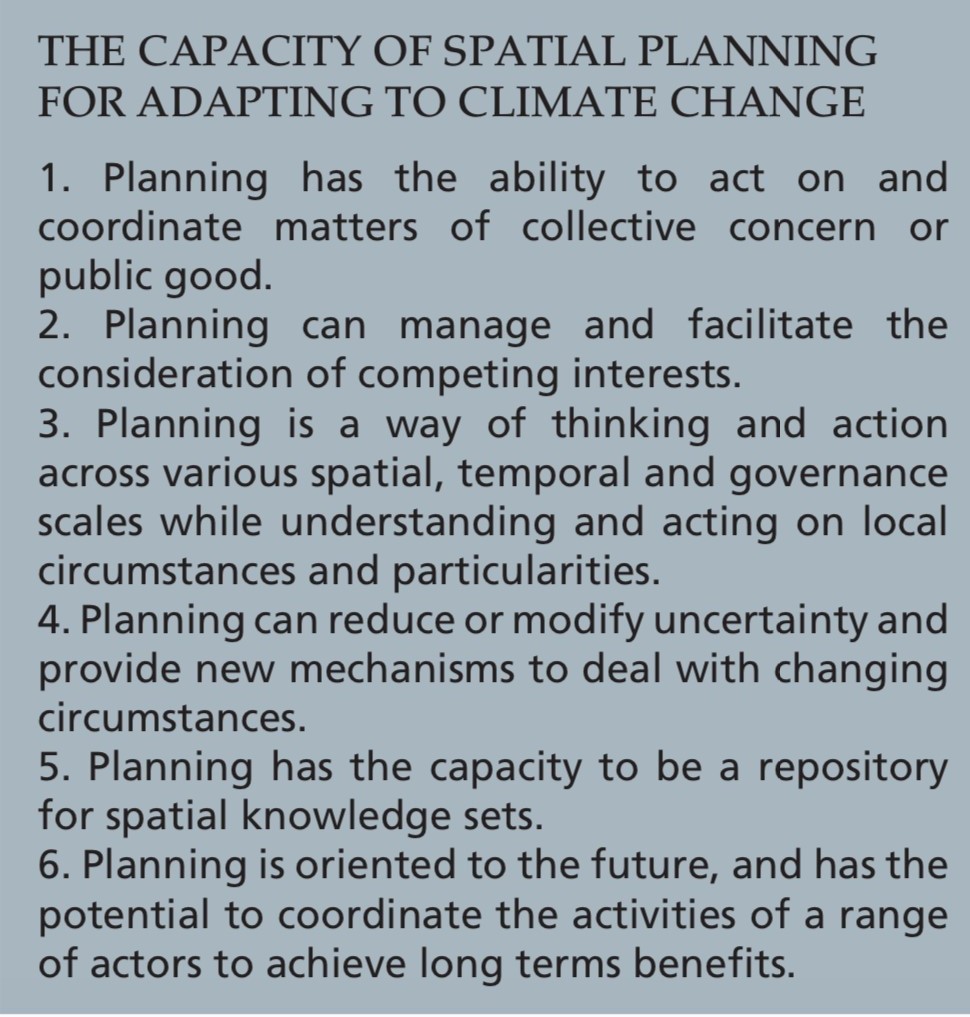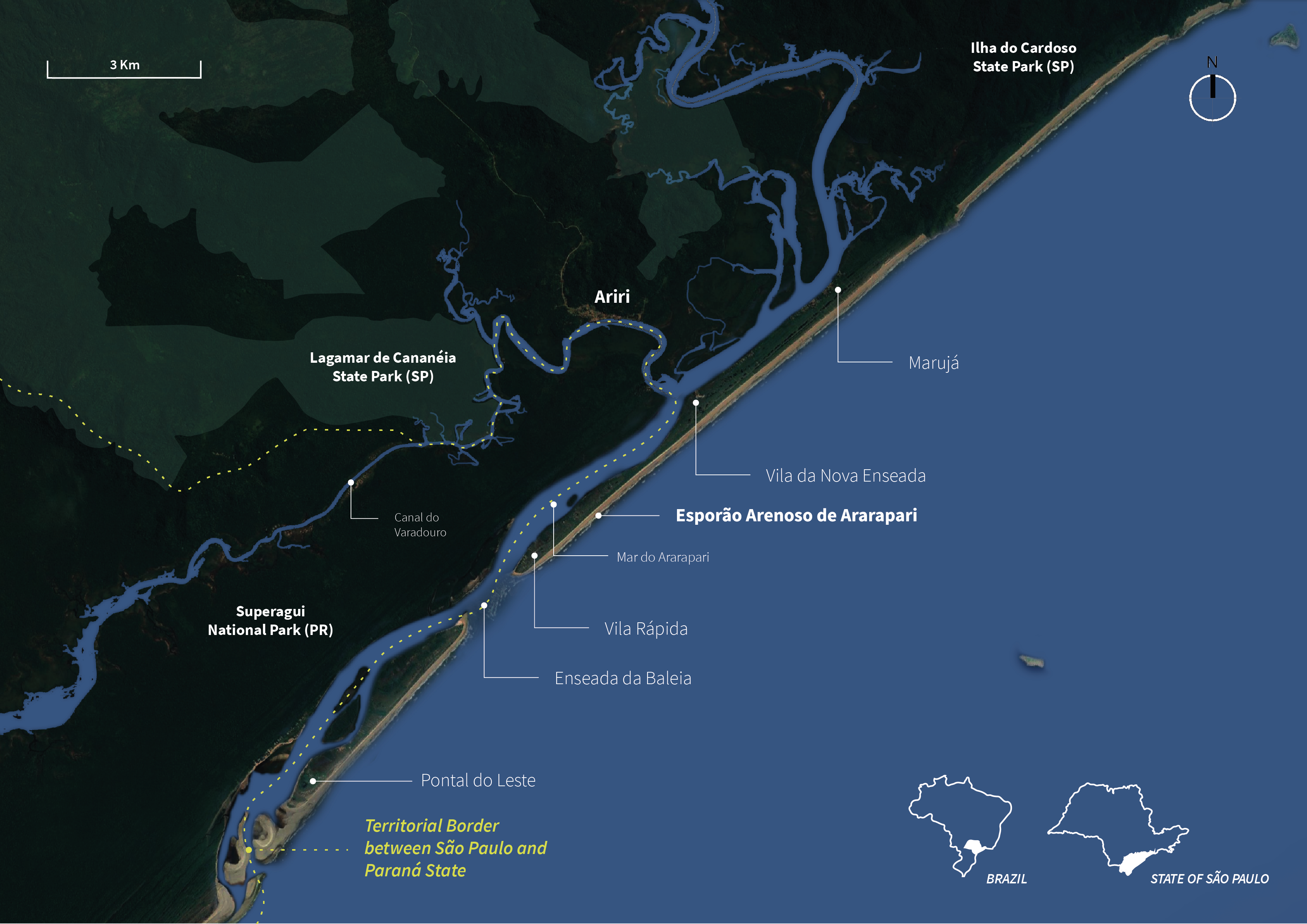Reaction or anticipation? The role of urban and regional planning in adapting to the climate emergency

By Pedro Henrique Campello Torres, Institute of Energy and Environment (IEE), University of São Paulo (USP), Brazil
Introduction
The incidence of severe climatic events (rains, droughts, floods, and hurricanes) has increased in recent years, and it tends to increase with the worsening of the climate emergency. It is not a new idea that cities have been considered an essential locus of action for global climate problems, either because they are essential vectors of CO2 emissions, or because they will suffer of its negative affects forcing them to adapt. It may also be due to the lack of legally binding and robust agreements and the role of national governments. Thinking or rethinking the role of urban and regional planning in the face of this challenge seems imperative (Davoudi, Crawford, Mehmood, 2009; Hurlimann & March 2012; Rickards et al. 2014).
Both in reports by the Intergovernmental Panel on Climate Change (IPCC), and in the recent article “Six research priorities for cities and climate change” (Bai et al. 2018), cities and their urban planning appear as fundamental to thinking about a future with fair sustainability. Nevertheless, there are still many “gaps,” barriers and challenges, especially in the most urbanized part of the planet, Latin America (Simões et al. 2017) and in regions which are projected to become the most urbanized in the coming decades: Africa and Asia.
Climate change scenarios indicate that by 2050, three billion people are expected to live in slums and precarious settlements, exposed to the effects of climate change. How will these cities be produced and planned? As early as 2010, urban planner Ray Quay presented proposals and tools for adapting to climate change, which he coined as Anticipatory Governance (Quay, 2010). Quay explained that the process for a response could be simplified into four distinct phases: (1) anticipate a wide range of possible futures; (2) develop multiple strategies; (3) monitor changing conditions over time; (4) act as anticipated and evaluate your progress.
However, these tools do not usually work the same way across all parts of the planet. In the context of the Global South, for example, dialogue regarding notions such as inequality and environmental justice, as well as climate justice, is most imperative (Travassos et al. 2020). Otherwise, there is a risk of producing the type of planning that engenders poverty and inequality in these regions.
A growing collection of literature has illuminated this issue, although there are still few empirical studies focusing on the territory of the Global South with researchers from the Global South, and even fewer, quantitatively, in Latin America. Barton (2013) has worked on Chile’s theme, making a significant contribution based on the peculiarities of the most urbanized region on the planet, South America. The work led by Shi L. et al. (2016) is another critical example of the need to approach the debate on inequality concerning planning for adaptation to climate change. Adaptation projects or green infrastructure should not reinforce inequalities; on the contrary, it is necessary to attack adaptation and inequalities at once (Pelling & Garschagen, 2019).
Action or Reaction?
What is working with urban and regional planning related to climate change? Planning is already, to some extent, an anticipatory practice. A short, medium or long-term plan contains components of uncertainty on how future development paths will unfold. For this reason, the increasing importance of plans that contain indications for monitoring and periodic review is crucial in order to adapt to any eventuality.
It is, therefore, about working within a scenario of uncertainty. The component of climatic variability includes even more unpredictability in planning since it demands the need to work with the best available scientific data, often where a knowledge gap exists in several locations. Additionally, if the importance of environmental governance of cross-scale commons is already considered a panacea in urban and regional planning and climate change, it still encounters barriers that range from the non-existence of regional institutions to the absence of future scenarios on a regional scale.
The interdependence of natural resources related to water supply, for example, needs to be addressed on a macro scale, and involves stakeholders and an extrapolation of the traditional frontiers and business as usual, the usual paths of planning and management. Water scarcity that can be verified in several metropolises on the planet has shown evidence, for some time, of the distance between the territory of production of the ecosystem service and consumption.
Planning becomes essential in this scenario as it can also contribute as a node for an interdisciplinary articulation of responses and reflections to the challenges that arise. In Figure 1, Hurlimann and March (2012) indicate six capacities of special planning for adapting to climate change. I would add that planning could articulate responses addressing the climate issue, as well as the yearnings for reducing inequalities in space. For this, dialogue focusing on climate justice is essential, a term originating in the Global North and still unusual in Latin America (Torres et al. 2020).
Porter, Rickards, Moloney and Anguelovski, I. (2020) recently organized a section in Planning Theory & Practice entitled, “Climate Justice in a Climate Changed World.” It is a must read, principally, the article, “Towards an Emancipatory Urban Climate Justice Through Adaptation?” by Isabelle Anguelovski and David N. Pellow. However, there is an absence of voices/authors from the Global South, which has been recurring and can be explained by several reasons, including, amongst others, the priority and necessity of the inequality agenda (Torres et al. 2020).
Figure 1. Six capacities of special planning for adapting to climate change

Source: Hurlimann & March (2012).
Urban and regional planning in the face of climate change, therefore, needs to adjust its practice to local demands. The best way to do this is not only from a formal participatory planning process; it is necessary to go beyond that. It is about ensuring the necessary arena for community actors to propose actions, breaking the business as usual paradigms of current practices. It is not a question of including the bottom-up discussion. Nevertheless, it must be done from there.
In this case, what may seem local will actually be evidence of the well-known and widespread term, glocal. This speaks to a specific event, to a lesser extent local, yet highly interconnected with other territories and their natural resources. The following case study conveys this idea. Although it seems like a small case within a limited territory, it highlights what is to come in a country like Brazil, with an extensive urbanized coast where several capitals are located, such as Rio de Janeiro, Salvador, and Recife, amongst others.
Anticipatory action (or re-action) on the coast of São Paulo, Brazil
Brazil has historically tried to face its main CO2 emission vector, deforestation, especially in the Amazon region. Urban and adaptation focus has been relegated to the background, at least until 2016 when the National Adaptation Plan was published. Evidence of this is the Brazilian Nationally Determined Contribution (NDC), itself taking on the Paris Agreement in which deforestation and new renewables are now priorities.
The State of São Paulo has had a State Policy on climate change since 2009. In practice, however, policies seem to be only discussed and implemented within the scope of urban and regional planning instruments, such as the Ecological Economic Zoning. The case of the Ilha do Cardoso State Park is a rare example of anticipatory planning in the country. Another relevant peculiarity was the key role played by their residents (Yamaoka et al. 2019). Although it seems local, it is a case that has a multiplier effect throughout different areas of the country, as well as emphasizing the problem of land regularization and traditional communities.
Ilha do Cardoso (IC) (Figure 2), located in the municipality of Cananéia, on the South Coast of São Paulo State, has been a state park since 1962. In the area known as Enseada da Baleia, two “caiçaras” communities live, surviving on community tourism and artisan fishing.
Figure 2. Enseada da Baleia (EB), Ilha do Cardoso State Park, São Paulo Brazil.

Credits: Igor Matheus Santana Chaves, 2020.
Based on technical studies that predicted the erosion of the territory, the Public Attorney asked the competent bodies to analyse both the geological situation and the need to remove families. Between 2012 and 2015, consultations took place with the community involved to expose the evolution of sedimentary processes and discuss the removal of residents. The community decided to start its monitoring of critical erosion points in the village as of 2015.
In 2016, three intense wave events with anomalous high tides (May, August, and October) completely eroded the territory. The Alert state was then triggered and the execution of the Contingency Plan began. In December 2016, an area was assigned to relocate Enseada da Baleia community, south of Marujá (Figure 2), in mutual agreement between the families and the bodies involved (Souza et al. 2019). The criteria adopted for this selection were: a) environmental – the interior of the spur and north of the Varadouro Canal, continuity of traditional activities, low susceptibility to erosion, degraded/altered vegetation, adequate solutions for water, sewage and electricity, and low environmental impact; and b) legal – legal impediments and land tenure regularization.
The Enseada da Baleia community then started an awareness movement with social networks in search of resources to carry out its relocation process, which was completed in mid-2017. The acceptance on the part of the Enseada da Baleia community to leave its territory of origin before an inevitable disaster, made possible a planned and organized reallocation, including the search for financial and material resources, and the accomplishment of joint efforts for the construction of new housing and various community structures. With the reconstruction of the “Nova Enseada,” the community became one of the main references for community-based tourism along the South Coast of São Paulo.
Final remarks
Urban and regional planning in the face of climate change will necessarily have to incorporate dialogue with what Quay (2010) proposes as anticipatory governance, trading the current planning system for a new one. In this sense, it will also be imperative to understand the importance and use of models and scenarios of the impact of climate change within the territory, on the part of planners and technicians.
Conversely, especially in the Global South, the problem needs to be tackled with two complementary fronts: adaptation to the climate and social inequalities. In this sense, the debate on justice and inequality need to be contained in the planning, not only including the communities in the planning process, but creating arenas in which they can propose and plan their demands, equipping them with the available scenarios and technologies that expose the risks and their vulnerabilities.
It is also essential to ensure that the global-local (glocal) understanding distinguishes the cross-scale dimensions of ecosystem services that will be impacted and need to be confronted locally from a regional perspective, especially in megacities or city-regions. Planning to face the contemporary challenge of climate emergence is not a complex challenge, but one that needs to be faced. Business as usual planning does not work and will not work to deal with such complexity. Empirical research, sharing of experiences, and proper implementation practices are fundamental in this process of building the scientific field.
Acknowledgments
The author would like to thank the São Paulo Research Foundation (FAPESP) for financial support (Grant Number 2019/05644-0 and 2015/03804-9).
References
Agyeman, J., Bullard, R. and Evans, B. (2003), “Just Sustainabilities,” Management of Environmental Quality, Vol. 14 No. 3, pp. 425-426.
Bai, X, R., Dawson, D., Ürge-Vorsatz, Delgado, G., Barau, A., Dhakal, S., Dodman, D., Leonardsen, L., Masson-Delmotte V., Roberts D. (2018), “Six research priorities for cities and climate change,” Nature Vol 555, No 7694, pages 23–25, 2018.
Barton J.R. (2013), “Climate Change Adaptation and Socio-ecological Justice in Chile’s Metropolitan Areas: The Role of Spatial Planning Instruments”. In: Boone C., Fragkias M. (eds) Urbanization and Sustainability. Human-Environment Interactions, vol 3. Springer, Dordrecht
Davoudi, S; Crawford, J; Mehmood, A. (2009), Planning for Climate Change. Strategies for mitigation and adaptation for spatial planners. London, EarthScan.
Hurlimann, A C; March, Alan P. (2012), “The role of spatial planning in adapting to climate change”. WIREs Climate Change. Volume 3, Issue 5. Pages 477-488, 2012.
Pelling M, Garschagen M. (2019). Put equity first in climate adaptation. Nature 569, 327-329.
Porter, L., Rickards, L., Moloney, S., & Anguelovski, I. (2020). Climate Justice in a Climate Changed World. Planning Theory & Practice, 1–29.
Quay, R. (2010). Anticipatory governance – a tool for climate change adaptation. Journal of the American Planning Association, v. 67, n. 4, p. 496-511.
Rickards, L., Ison, R., Fünfgeld, H., & Wiseman, J. (2014). Opening and Closing the Future: Climate Change, Adaptation, and Scenario Planning. Environment and Planning C: Government and Policy, 32(4), 587–602.
Shi L. et al. (2016). Roadmap towards justice in urban climate adaptation research. Nature Climate Change. Vol. 6.
Simões, E., de Sousa Junior, W.C., de Freitas, D.M. et al. (2017) Barriers and opportunities for adapting to climate change on the North Coast of São Paulo, Brazil. Reg Environ Change 17, 1739–1750.
Souza, C. R. G.; Cheliz, P. M.; Costa, R. P.; Nascimento, E. R.; Pisciota, K.; SOUZA, M. J. O Processo Erosivo na Enseada da Baleia, Parque Estadual da Ilha do Cardoso (Cananéia/SP): Exemplo de Adaptação a Riscos Costeiros. O Processo Erosivo na Enseada da Baleia, Parque Estadual da Ilha do Cardoso (Cananéia/SP): Exemplo de Adaptação a Riscos Costeiros. 1ed.São Paulo: IEE-USP, 2019, v. 1, p. 129-.
Torres, P. H. C. et al. (2020) Is the Brazilian National Climate Change Adaptation Plan addressing inequality? Climate and Environmental Justice in a Global South perspective. Environmental Justice.
Travassos, L.; Torres, P. H. C.; Giulio, G. M.; Jacobi, P. R.; Freitas, E. D.; Siqueira, I.; Ambrizzi, T. (2020) Why do extreme events still kill in the São Paulo Macrometropolis? Chronicle of a Death Foretold in the Global South. International Journal of Urban Sustainable Development.
Yamaoka, J G; Cardoso, T M; Denardin V F; Alves, A R. (2019). A comunidade caiçara da Enseada da Baleia e a sua luta pelo território – Cananéia (SP). GUAJU REVISTA BRASILEIRA DE DESENVOLVIMENTO TERRITORIAL SUSTENTÁVEL, v. 5, p. 138-165.